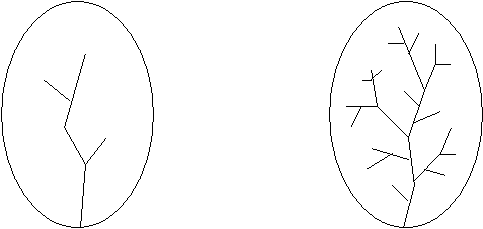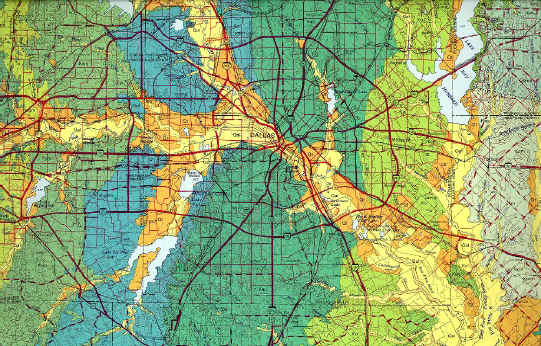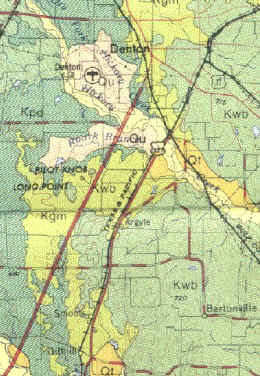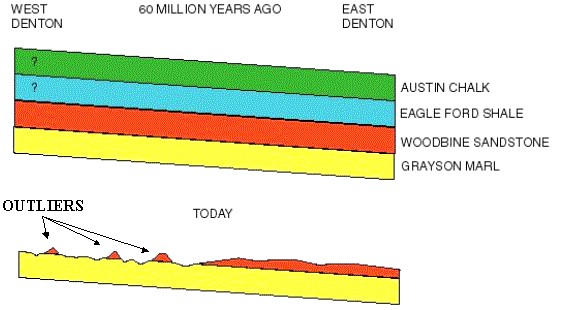
Stream Networks
The distribution of channels forms a hierarchy of small headwater channels draining into progressively larger channels downstream. Most channel networks evolve by headward erosion, perhaps along rills and gullies, to the point where water and sediment supplied from the surrounding DRAINAGE BASIN (delimited by a DRAINAGE DIVIDE) can be efficiently removed. One question is how many channels will form within a drainage basin? when will the channel network stop growing? The concentration of channels within a drainage basin is measured by DRAINAGE DENSITY (total channel length/drainage basin area).


In answer to the question, the drainage density depends on the minimum area required to supply sufficient run-off (HOF, SOF, interflow) to a channel to maintain it against in-filling by mass wasting of its banks. The amount of run-off depends on climate, vegetation and surface infiltration rate; for example, in semi-arid areas, vegetation is sparse, surface infiltration is low and rainfall is often intense -> small area can produce large amount of run-off -> large drainage density. In any climatic area, variations in factors such as slope, rock type and vegetation will result in local variations in drainage density.
Drainage Patterns
The actual pattern of channels usually reflects the regional geologic
structure and topography:
RADIAL: channels drain dome-shaped geologic structures or volcanic cones; the streams radiate out from the central high point.
RECTANGULAR - usually form where streams have exploited rectangular networks of joints in rocks such as granite.
TRELLIS - form on parallel outcrops of rocks of varying resistance; main streams occupy strike valleys; shorter tributaries drain intervening ridges and join main streams at approximately right angles.
PARALLEL - main streams are all aligned in approximately the same direction; usually form where streams follow a regional slope.
DENDRITIC - a branching pattern, probably the most common, forms where rocks are fairly uniform or where there is no strong structural control on drainage patterns.
Apart from influencing the regional drainage pattern, geology will also influence the location of individual streams within a drainage basin via the action of differential erosion -i.e. as the landscape is worn down by erosion, streams will naturally tend to occupy lines of weakness caused by different rock types, faults or joints, or slight variations in rock strength.
Example: Regional And Local Drainage Patterns In The DFW Region.
In Dallas County, the main stream is the Trinity River, which is a consequent stream (follows the regional slope to the southeast). Major tributaries of the Trinity are usually subsequent streams occupying strike valleys.

Village Creek is another subsequent stream occupying a strike valley formed in the Grayson Marl. A PARALLEL stream network pattern has formed down the dipslope of the Austin Chalk cuesta. In prominent strike valleys, such as Mountain Creek valley, TRELLIS patterns may develop.
Clearly there are many streams in this region - many of the "dips" in the landscape are therefore stream valleys resulting from stream erosion and hill slope erosion processes. Many of the hills are interfluves (drainage divide between two stream valleys) or more resistant rock outcrops which have been left standing higher by differential erosion (e.g. White Rock escarpment).

Valleys and interfluves in Denton: imagine driving the road from east to west -
there is a continuous series of "ups" and "downs".
In the Denton area, for example, many hills are outliers of resistant Woodbine Sandstone (masses of rock "cut off" from the main outcrop on the east side of town). Areas underlain by Woodbine Sandstone in Denton are easily recognized because they tend to be higher, covered by oak trees and have sandy soil, often exposed in road cuts (e.g. Southridge, TWU).

Some of the outliers are Crawford Hill, Long Point, Pilot Knob to the southwest, the hills under the Radisson Hotel, McKenna Park and Flow Hospital near the UNT campus.
One of the implications of this is that Woodbine Sandstone, as well as other Upper Cretaceous rocks, once covered the Denton area; these rocks have been differentially eroded over the last 60 million years, resulting in the present-day landscape. How much rock has been eroded? This is uncertain, but estimates are in the range of 1000 - 1500 feet.

Example Questions:
1. Define "drainage density". Why do semi-arid areas have high drainage densities?
2. Describe (with diagrams) five common drainage patterns and explain the origin of each.
3. Explain how stream erosion, bedrock outcrops and outliers have formed the major features of the landscape in the Denton area.